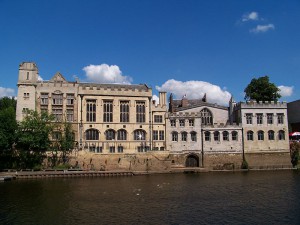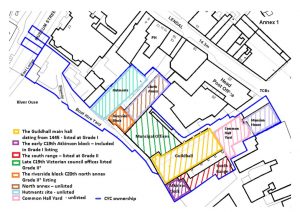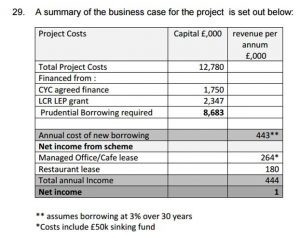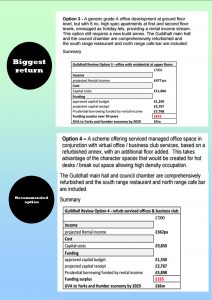
York Guildhall
The York Council has failed to find a commercial partner to sustain the planned small business club which will occupy a refurbished Guildhall.
It means that Council officials will attempt to directly manage the taxpayer funded facility with £12.4 million at risk.
At best, the business plan being considered by the Council’s Executive next week would see a minimal forecast surplus of £1000 a year on the investment. This would be after covering interest charges on the planned £8.7 million of extra borrowing needed to fund the project.
However, this does not include the need to fund a direct grant of £1.759 million from the Council’s capital programme (part of which is also funded through borrowing) or the need to repay loans to the Councils internal “Venture Fund” which is set to bear revenue losses on the project of over £568,000 during the next 5 years.
Taxpayers will also indirectly fund a £2.5 million contribution from the Leeds City Region “Local Enterprise Partnership” which may also have to be repaid from any surplus.
As recently as July, the Council was saying that it could only recoup around £500,000 from the rent of office space. Now it says that £785,000 a year is possible, at “88%” occupancy levels, plus £25,000 for the rent of café/bar space. 
The project is also dependent on leasing a large section of the building for use as a restaurant. This element is expected bring in £180.000 a year in rent income.
The viability of a (separate) bar/café is dependent on securing a licence on what is a site – under the Councils own rules – located within a “cumulative impact zone” where alcohol abuse has become a significant problem for the City.
The project has had a very chequered history.
 The Guildhall was effectively abandoned in 2013 by the then Labour controlled Council when they upped desks and moved to West Offices. They opted in 2013 for a £1.4 million conversion into a “Digital and Media Centre” (DMC).
The Guildhall was effectively abandoned in 2013 by the then Labour controlled Council when they upped desks and moved to West Offices. They opted in 2013 for a £1.4 million conversion into a “Digital and Media Centre” (DMC).
The listed buildings were left empty and their condition rapidly declined to the point where a £2.5 million backlog in maintenance work developed.
The Council went through a time consuming and expensive design competition, but it was late 2014 before they confirmed their intention to use the buildings for a DMC.
By then costs had escalated to £9.2 million.

2016 options
An incoming coalition Council in May 2015 seemed to be transfixed by the problem, but after 12 months they scrapped the media centre plan instead opting for a seemly safer business centre scheme.
They rejected a less risky, and financially more prudent, option which would have seen some residential units provided on the site.
A Heritage Lottery bid was turned down leaving the Council to seek commercial partners.
These have also now failed to materialise.
At no time has the sale of the site been tested on the open market.
The Council has an indifferent track record when trying to directly manage specialist facilities. The Barbican concert hall and pool – which cost taxpayers nearly £1 million a year in subsidies, in addition to a capital construction cost of £12 million – remains fresh in many memories.
The Barbican eventually had to be leased to a professional leisure operator.
The refurbishment of the Mansion House, which is adjacent to the Guildhall, is also running 12 months behind schedule.
& then there is the Community Stadium saga!
So we doubt whether we have heard the last of the Guildhall project.

